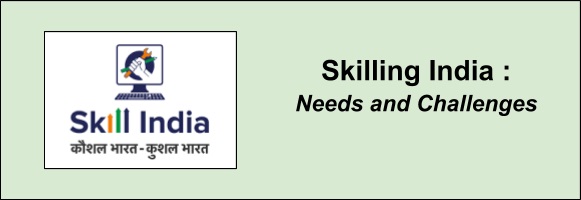(HOT) UPSC Current Affairs 2025 PDF
NEW! The Gist (NOV-2025) | E-BOOKS
Skilling India - Needs and Challenges : Important Topics for UPSC Exams

Skilling India - Needs and Challenges : Important Topics for UPSC Exams
Introduction
-
India is passing through a phase of unprecedented demographic changes, wherein the proportion of the working age population (15-59 years) is likely to rise from around 58 per cent in 2001 to over 64 per cent by 2021, according to a Survey.
-
Current predictions suggest a steady increase in the youth population to 464 million by 2021 and finally a decline to 458 million by 2026.
-
In order to survive in their respective field and also to face the high level of competition in future people will have to skill multiple times and periodic upgradation of skill will be needed.
Why skilling is needed
-
Diversification of economy: from being largely agro-based to a manufacturing and service-based economy. So diverse skill is needed to accomodate the workforce in new sector
-
Outdated skills : our most of the workforce is hampered with outdated skills.So Market-relevant skills are needed in today’s highly competitive job market.
-
Technological advancement: due to which blue collar jobs will become increasingly scarce so high skill is needed to be relevant in the market.
-
Demand of skilled worker: according to a government’s analysis by 2022, 24 sectors will need an additional 109 million skilled workers.

Buy Printed Complete Study Materials for UPSC IAS PRELIMS Exam
Online Crash Course for UPSC PRE Exam
image credit: The Financial express
-
Skill shortage in India: Organization for Economic Co-operation and Development (OECD) data shows severe skills shortage in India.
-
Driver of future economic growth: country’s young and dynamic population has been regarded as the driver of future economic growth but this young population need to be skilled.
-
To meet global demand: India being youngest country can become supplier of human resource to world whose population is growing old if youths are skilled properly.
Steps taken by government
-
Skill India mission: launched by government which ambitiously aims to train over 400 million people in India in different skills by 2022.
-
Promoting apprenticeship: government is promoting apprenticeship and also allowed providing apprenticeship to non-engineering stream. 500 new trades is included in apprenticeship.
-
Sankalp project: it is launched by government for Livelihood Promotion’ project to enhance skill.
Challenges
-
Multiple skill in one is lacking: gone are the days in which one skill was enough to be relevant in market now a worker need to be skilled in multiple area to be relevant in market.
-
Double burden on NSDC: National Skill Development Corporation has been given the task with managing the financing processes while at the same time implementing the skilling programmes.
-
Absence of job linkages:skill training has improved in recent years but the absence of job linkages with training is increasing the problem of unemployment.
-
Low placement: data shows that out of the 30.67 lakh only 2.9 lakh trained candidates had received placement offers in june 2017
-
Training still mainly in traditional area: With technological advancement, conventional jobs are becoming sparse so need training in modern field.
-
The red tapism: it is creating hindrance in the interaction between the industry and the skilling institutions due to which skilling is suffering.
-
Huge target: skilling 400 million young Indians by 2022 is in itself a herculean task.
-
Lack of industry relevant education: Skilling programmes are not the only requirement for employability creation. The education system is the primary incubator but sadly it is lacking in India.
Way Forward
-
Finance issue: absolved NSDC from the financing duty so that it can focus on its core competencies on skilling programme to make it a big success.
-
Multi-skilling in one: is the demand in the present world with economy and requirement changing at unprecedented scale
-
Periodic upgradation: electricians, plumbers, agricultural machine operators and other skilled trade workers are needed to update their skills regularly.
-
Practical approach, where instructors must employ case studies and present relevant problems so that better skill and practical skill can be taught.
-
Complementary part of mainstream education: Skill training should not be viewed as replacement to the mainstream education but as a support in the same.
-
Reduce bureaucratic red tape: to enusre proper industry and skilling center linkage to drive the skilling in right direction.
-
Industry relevant training: the couriculum should be in sync with industry demand and the practical trainings should be more emphasised upon rather than just theoretical work.
-
Inclusive skilling: skill all section of women, marginalized communities, tribals and disable people to increase their employability.
MODEL QUESTIONS
Civil Services Preliminary Examination
1. Unemployment which occurs in between the movement from one job to another job is known as:
a. Unemployment
b. Frictional unemployment
c. Technological unemployment
d. Seasonal unemployment
Correct answer: b
Civil Services Mains Examination

